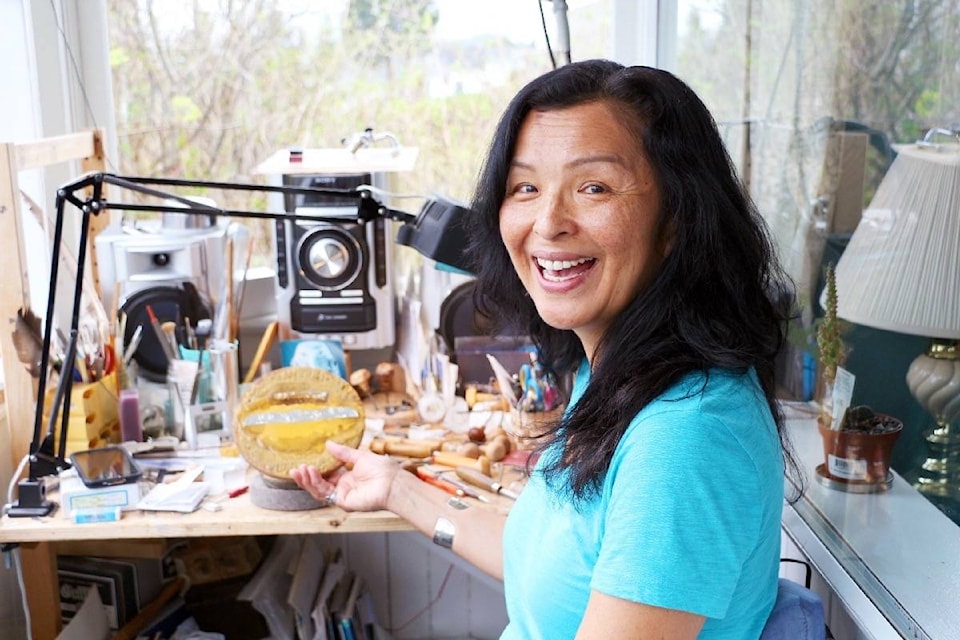Whether its glass, metal or wood, one of the few female carvers on the North Coast can draw a story from each piece she works on.
Growing up, Dale Campbell explored the boundaries of her creativity with knitting, pottery, beading and sewing. The only reason she wasn’t able to try her hand at metal and woodworking at school was because she was a girl.
Then in 1972, her cousin and prolific First Nations carver, Dempsey Bob, invited her to join a workshop with him and the renowned female carver, Freda Diesing.
“I was like, ‘Oh yeah? A woman carver right.’ So I went down there,” Campbell said. “When I started carving I was working with wood and right off the bat they started teaching us how to make our own knives, metal work. I was so happy.”
She fell in love with carving, and took to the craft immediately. For three years she worked one-on-one with Dempsey Bob until he told her that he taught her as much as he could, and it was time she went out on her own.
Around the same time Campbell also became curious about her Tahltan-Tlingit roots. Her parents had moved from Telegraph Creek to find work in the city, and she had only ever heard stories about the traditions, the lifestyle, hunting and fishing.
In the summer months, she travelled north and learned how to run nets on the river, she hunted and learned how to skin a bear, and for five months she lived in a tent frame.
“By doing that it gave me a sense of who I am and where I come from,” Campbell said.
To add another layer to Campbell in these formative years, she took up karate. Although she had a natural talent as an artist, she had trouble finding her focus. Karate helped her find it.
Since 1980, when she first stepped into a dojo, she’s competed all over the province, has achieved a third degree black belt — and she met her husband, Wade Wilkins. Together they ran the dojo in the Fisherman’s Hall for many years.
But shifting back to when Campbell rediscovered her heritage in her visits to Telegraph Creek. Shortly after, she was asked to be a part of the National Aboriginal Role Model Program. Campbell would travel to indigenous communities across Canada to speak with the youth and put on workshops on either carving or karate.
Her art has taken her all over the world as well. She went to Australia when a button blanket she stitched was featured in an art show in Adelaide. Last summer, she was invited to show her work at the Santa Fe Indian Market, which sees more than 100,000 visitors from around the world. At the two-day event, Campbell took away two first-place ribbons for her wood carvings.
She’s heading back to the market in New Mexico this August, and is busy preparing her jewellery in her studio where she gathers inspiration from dancing eagles and views of the ocean. Although she sells her work in Vancouver, Victoria and Seattle, she has chosen to stay in Prince Rupert.
“It’s pretty laid back, and it’s quiet and I love nature, I love walking out in the bush and hiking. That gives me a real sense of peace,” Campbell said.
From the distant North Coast city, Campbell is still able to make her mark with her art. In 2013, she received the BC Creative Achievement Award for First Nation Art from the provincial government. The honour came after years of carving wood and metal.
In 1982, along with her brother Terrence Campbell and Haida artist Alvin Adkins, she helped design and carve the 30-foot totem pole that stands next to the Museum of Northern B.C.
Then, she and her brother spent three years carving another 30-foot pole. But they didn’t have a buyer for it, and without the Internet, she sent letters to embassies and museums around the world to sell the piece.
She struck gold, when Prime Minister Brian Mulroney took interest and the Canadian government purchased the totem pole to give to the people of Hong Kong in 1991.
They were invited to join the dignitaries in Hong Kong and she met with the prime minister and his wife.
“We had our button blankets on and they put the totem pole up just for the prime minister and after, we told the Chinese people that it’s bad luck to raise the pole twice, so they kept that pole up. They came across on a barge with it standing up until the official pole raising July 1, 1991 in Kowloon Park — and it still stands there today,” she said.
The siblings spent five weeks in Hong Kong where they carved an eight-foot pole while people watched them work. At one point, they worked inside a massive shopping mall where thousands of people passed through.
Grateful, is one word that Campbell uses to describe being able to be a full-time artist.
When she engraves metal for jewellery, she is completely focused, riding the wave of the movement of her tools and the curves of her art. On her desk, she has written out a mantra that she reminds herself of while she works.
“I am doing my best and my best is good enough.”
